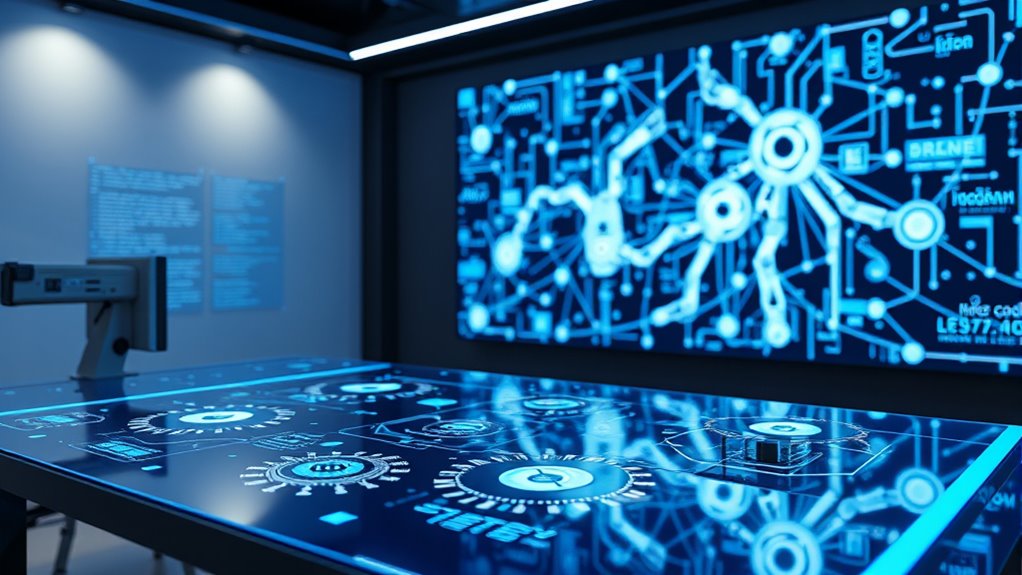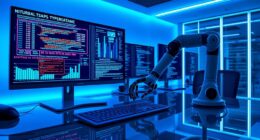Hyperautomation combines RPA, AI, and ML to automate complex business processes, going beyond simple tasks. It helps you analyze data in real-time, make smarter decisions, and adapt workflows automatically. This approach reduces errors, speeds up operations, and continuously improves efficiency without constant manual updates. By integrating advanced technology, hyperautomation transforms how organizations work at every level. If you want to discover how it can revolutionize your operations further, you’ll find valuable insights ahead.
Key Takeaways
- Hyperautomation combines RPA, AI, and ML to automate complex, end-to-end business processes.
- It enables systems to analyze data, make decisions, and adapt in real-time for continuous improvement.
- AI integration enhances automation by interpreting unstructured data and reducing manual errors.
- It provides strategic insights by analyzing data generated during automated workflows, improving decision-making.
- Hyperautomation transforms organizational functions, promoting smarter, more efficient, and adaptable operations.

Hyperautomation is transforming how businesses operate by combining advanced technologies such as robotic process automation (RPA), artificial intelligence (AI), and machine learning (ML) to automate complex processes. This integration allows you to streamline workflows, reduce manual effort, and improve overall efficiency. One of the key drivers behind hyperautomation’s success is AI integration, which empowers systems to analyze data, make decisions, and adapt in real-time. By embedding AI within automated processes, you can achieve smarter operations that go beyond simple task execution, enabling your organization to handle more sophisticated and nuanced functions seamlessly.
With AI integration, process optimization becomes more effective and dynamic. Traditional automation often relies on static rules, which can limit flexibility and scalability. Hyperautomation, however, leverages AI and ML to continuously learn from data and refine workflows. This means your processes become more adaptable, capable of identifying bottlenecks, errors, or inefficiencies on the fly, and adjusting accordingly. As a result, you don’t just automate tasks—you enhance the entire process, making it more resilient and responsive to changing business needs. For example, AI can analyze customer interactions and predict future demands, allowing you to proactively adjust inventories or staffing levels, *consequently* optimizing resource allocation.
AI-driven hyperautomation enhances flexibility, optimizes resources, and enables adaptive workflows for smarter business operations.
Furthermore, AI integration in hyperautomation helps reduce errors and improve accuracy across operations. Automated processes powered by AI can interpret unstructured data, such as emails or documents, which traditionally required manual input. This not only speeds up workflows but also minimizes human error, leading to more reliable outputs. When combined with process optimization, AI enables you to identify repetitive tasks that can be automated and fine-tune them for maximum efficiency. Over time, the system learns from its performance, continuously improving itself without requiring constant manual reprogramming. Crochet styles for locs are an example of how creative customization can also be integrated into automated workflows for personal styling.
In addition, AI-driven hyperautomation offers significant insights that inform strategic decisions. By analyzing data generated by automated processes, you gain a deeper understanding of your operations, customer behavior, and market trends. This intelligence can be used to refine your automation strategies, further enhancing process optimization efforts. Ultimately, AI integration within hyperautomation acts as the backbone of smarter, faster, and more adaptable business processes, giving you a competitive edge in today’s rapidly evolving landscape. It’s not just about automating tasks—it’s about transforming how your organization functions at every level.
Frequently Asked Questions
How Does Hyperautomation Differ From Traditional Automation?
Hyperautomation differs from traditional automation because it combines multiple automation tools through advanced automation integration, enabling you to automate complex tasks more efficiently. While traditional automation focuses on automating simple, repetitive processes, hyperautomation emphasizes process optimization by integrating AI, RPA, and other technologies. This approach allows you to streamline entire workflows, improve decision-making, and adapt quickly, ultimately delivering greater operational efficiency and agility.
What Industries Benefit Most From Hyperautomation?
You’ll find industries like manufacturing, healthcare, finance, and retail benefit most from hyperautomation. By integrating AI and data analytics, these sectors streamline complex processes, improve decision-making, and boost efficiency. You can expect faster, more accurate results, reduced manual effort, and better customer experiences. With hyperautomation, you’re empowered to automate end-to-end workflows, making your operations more agile and competitive across diverse industry landscapes.
What Are the Key Challenges in Implementing Hyperautomation?
When implementing hyperautomation, you face challenges like managing change and ensuring data security. For example, a financial firm struggled with employee resistance during automation rollout, highlighting the importance of effective change management. Additionally, safeguarding sensitive data becomes critical as automation increases data flow. You must develop clear strategies to address these issues, involving staff training and robust security protocols, to successfully integrate hyperautomation into your processes.
How Does Hyperautomation Impact Employee Roles and Jobs?
Hyperautomation impacts your roles and jobs by requiring employee adaptation, as you learn to work alongside new technologies. While it can lead to job displacement in some areas, it also creates opportunities for you to develop new skills and take on more strategic tasks. Embracing these changes helps you stay relevant and adds value, ensuring that automation enhances your productivity rather than replacing you entirely.
What Future Trends Are Expected in Hyperautomation Development?
You’ll see future hyperautomation trends focus on advanced AI integration and predictive analytics to boost efficiency and decision-making. As these technologies evolve, expect more intelligent automation systems that adapt in real time, reducing manual tasks further. You’ll also notice increased customization, allowing businesses to tailor automation workflows to specific needs. Embracing these trends helps you stay competitive, leveraging smarter tools that enhance productivity and foster innovation in your organization.
Conclusion
Now that you understand hyperautomation, you’re stepping into a world where your business can run smoother than a rocket soaring through the sky. By combining advanced tools like AI, RPA, and analytics, you’re revealing incredible efficiencies and innovation. Embrace hyperautomation, and you’ll transform your operations so profoundly that it’ll seem like you’re wielding a superpower. The future isn’t just coming — it’s already here, waiting for you to harness its unstoppable energy.









